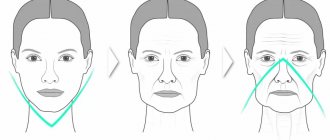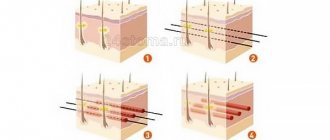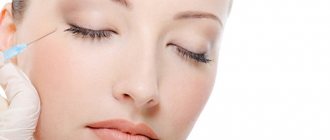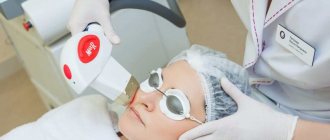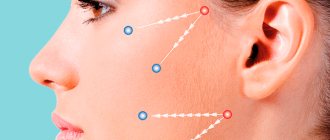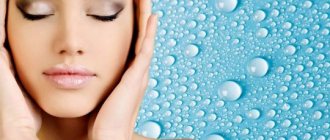Eyebrows are a very important element on a person’s face. They help to express many emotions (surprise, anger, doubt, etc.), mood, make the look expressive, and emphasize the beauty of the eyes. This is why women pay so much attention to caring for their eyebrows, giving them a harmonious shape, coloring them, even getting a tattoo. But as the years go by, the skin on the forehead becomes less elastic, the arches of the eyebrows droop, sometimes unevenly, a wrinkle forms between them, and other age-related changes occur. All this makes the face gloomy, tired, and unattractive. How to fix the situation?
An excellent alternative to plastic surgery for rejuvenating the upper part of the face, or rather the skin in the forehead area, is the popular eyebrow lifting with threads. This procedure is well developed, painless, as it is performed under local anesthesia, does not require long-term rehabilitation, and the result is noticeable quite quickly.
The implanted threads form a frame in the dermis that tightens the skin of the forehead, smooths out wrinkles on it and between the eyebrows, lifts the eyebrows and corners of the eyes, and eliminates sagging eyelids.
What material is used
For safe skin tightening that does not involve any incisions, cosmetology uses special surgical threads, which the specialist selects individually for each client, guided by the area of application, skin characteristics and the desired result. They are made from biocompatible hypoallergenic materials that, when introduced into the dermis, can form scar tissue - an internal fixation adhesion between the skin and muscles, stimulate the production of collagen types 1 and 3, and rejuvenate the skin at the cellular level, i.e. from the inside. They are inserted with the thinnest needles or cannulas.
There are two types of threads:
- biodegradable - resorbable. They are produced from a copolymer of L-lactide and e-caprolactone. This material is friendly to the human body and is an activator of collagen production, restoring youthful skin at the cellular level. The threads remain in the tissues for more than a year, and then, when they dissolve, they are excreted naturally. But the rejuvenating mechanism she launched continues to work;
- non-absorbable. Made from synthetic material polypropylene, used in surgery for almost half a century. Such threads have been tested for a long time, are safe, are not rejected by the body and help to obtain a long-lasting effect.
VIRTUSCLINIC specialists choose Aptos thread lifting technology and the material produced. The technique was created in 1996 by plastic surgeon M.A. Sulamanidze - the inventor of threads for tightening soft tissues. Its name is composed of the Latin “a” - “negation” and ptos - “omission”.
Absorbable for more than 360 days, Aptos threads have a unique composition and excellent rejuvenating properties. They are introduced through pinpoint punctures and reliably fix soft tissues in the required position thanks to special retaining notches until a reliable framework of its own collagen is formed in the skin. In assortment:
- Aptos Light Lift Thread 2G and Light Lift Needle 2G (classic and Soft, Blunt modifications) – threads are inserted with two double-edged needles through one puncture and distributed along the required contour in different directions. The tissues are tightened and the arch of the eyebrow gets the desired shape;
- Aptos Visage in Excellence Soft or Nano variants. Tightens, restores, reinforces tissues, moisturizes the skin of people of different ages;
- Aptos Nano Spring is an ideal delicate option for those with thin, delicate skin in the eyebrow area.
The cosmetology clinic offers you the following procedures:
- drug Laennec for rejuvenation;
- removal of blood vessels on the face;
- drug melsmon for rejuvenation;
- facial photorejuvenation;
- etc.
Cost of the lifting procedure
Prices for face lifting with threads primarily depend on the type of material used, the volume of planned manipulation, and the condition of the skin. During the consultation, the specialist will determine the area that needs rejuvenation and select the appropriate threads that will help achieve the most positive result.
On average, the cost of this type of lifting is quite high - from 1 thousand dollars. It is also worth considering the pricing policy of the clinic and its location. For example, in Moscow the price for a thread lift ranges from 40 to 100 thousand rubles. If the patient has grade 2 ptosis, the cost of the service can reach 170 – 200 thousand rubles.
Advantages and disadvantages
Thread lifting as a method of rejuvenation has the following advantages:
- low-traumatic - does not require incisions, and the punctures are very small and, as already mentioned, it is possible to simultaneously insert threads in different directions;
- there are no scars left, and visible marks from the finest needles heal very quickly;
- the effect remains for a long time - the period depends on the condition of the skin and the chosen threads;
- damage to large vessels is excluded;
- No long recovery is required after the procedure;
- no traces of intervention are visible - facial features do not change, but are restored to their previous appearance;
- eyebrows retain natural mobility;
- carried out quickly on an outpatient basis;
- reasonable price.
It is important to know: the specialist who performs the thread lifting procedure must be qualified as a cosmetologist and have a certificate confirming training in. You should only contact well-established clinics that employ certified specialists with the appropriate knowledge and experience
.
The disadvantages of thread lifting include:
- restriction of facial expressions for 7-14 days after implantation of threads;
- after the procedure you need to sleep on your back for 5-7 days;
- Do not go to the sauna or fitness classes for a while.
Endoscopic correction of forehead and eyebrows
If eyelid correction is not required, an endoscopic forehead lift is performed. This method is also called “no-incision surgery”, since the intervention is carried out through punctures of a few millimeters and leaves virtually no traces. The endoscopic method at one time became a real breakthrough in facial plastic surgery, and now this procedure is a common daily practice, which has almost completely replaced the classic method of open surgery with a bicoronal incision, which leaves a long scar along the hair growth from ear to ear.
As we have already said, an endoscopic forehead lift is performed without classic incisions and excision of excess skin tissue. Instead, plastic surgeons perform detachment surgery and then move and fix the soft tissue in a higher position. Small punctures through which endoscopic instruments are inserted are placed in the scalp, so there is no need to worry about noticeable scars.
Despite the fact that endoscopic surgery is performed without incisions, the surgeon has a clear view of everything that is happening in the surgical field thanks to a tiny camera that is inserted through a separate puncture. The image is enlarged and transferred to a large screen.
Thanks to the advent of endoscopic techniques, it was possible not only to completely rid the patient of scars and reduce the duration of the recovery period, but also to reduce the risks of postoperative complications such as innervation and vascularization disorders.
Pros and cons
It is recommended to resort to lifting with threads in the following cases:
- the presence of wrinkles between the eyebrows and on the forehead (degrees 2–3);
- asymmetry of eyebrows, their drooping;
- drooping corners of the eyes;
- drooping upper eyelid.
A thread lift is suitable for those patients who first turned to a cosmetologist with minor age-related skin changes, as well as for those who have repeatedly resorted to aesthetic procedures.
Contraindications to the procedure due to the introduction of biostimulating materials:
- bleeding disorder, hemophilia;
- oncological diseases;
- skin diseases;
- mental disorders;
- problems with the heart, blood vessels, endocrine system;
- diabetes;
- autoimmune and somatic diseases.
Thread lifting of eyebrows and forehead is not recommended for pregnant and breastfeeding mothers.
Relative contraindications
for the procedure: persons taking blood thinning medications, as well as during exacerbation of chronic diseases.
Those who have a predisposition to hypertrophic and keloid scarring should be careful. They are at risk of developing skin defects.
Video
Review of Silhouette Elevator:
“I had no doubt what was better for my face: threads or plastic surgery. I physically cannot perform the operation - I do not have the luxury of even spending a week on sick leave.
Thread facelift turned out to be a real salvation for me! I had the procedure on Friday and went back to work on Monday – the same, only younger and more beautiful! Nobody guessed what happened to me! As I was promised, the thread lift sculpts the face very naturally.”
Irina, 39 years old
Stages of the procedure
Thread lifting, like any lift, requires certain preparation. The cosmetologist begins with a consultation: he talks in detail about the technique, the material used and provides certificates for it, how many threads are needed.
The specialist examines the client’s medical history, asks him about existing diseases, the presence of allergic reactions, whether he has had operations, what cosmetic procedures he has undergone. In some cases, it may be necessary to undergo additional tests - this is necessary to prevent undesirable consequences and predict the timing of rehabilitation.
After studying the condition of the area where the threads will be implanted, their type, quantity and injection scheme are determined individually.
Forehead correction with endotins
Endoscopic forehead lift surgery can be performed using endotins. These are thin, absorbable strips equipped with sharp teeth to secure tissue (see detailed information on the use of endotins in facial plastic surgery).
Endotins make it possible to solve the problem of reliable and uniform tissue fixation without overload and the risk of tearing inherent in point fixation. Otherwise, the operation is the same as a regular endoscopic forehead lift.
Additional measures
Three days before the thread lifting procedure, implantation of threads requires:
- stop taking vasodilators and painkillers and alcohol
- do not visit the solarium, sauna or bathhouse, swimming pool;
- do not engage in active sports.
One day before, eliminate foods that cause swelling.
On the day of the event, 2 hours before the procedure, you should not smoke, as nicotine promotes vasospasm and impairs the access of oxygen to the body.
Eyebrow lifting: what is it?
Over the years, the face looks more tired; the skin becomes thinner, loses tone, and the color becomes dull. Without proper care, signs of wilting become more noticeable.
Collagen synthesis stops. “The first bells” appear after 30 years. The first areas to be hit are the neck and décolleté. Then the jawline and brow area lose elasticity.
Eyebrow threads: before and after photos
Eyebrow lifting with threads is an excellent alternative to plastic surgery and “beauty injections.” The essence of the procedure is to install threads or monofilaments (usually absorbable threads) into the subcutaneous fatty tissue. This is where they remain, causing a pronounced lifting effect.
Effect of the procedure
Thread lifting solves several problems at once:
- A facelift occurs - the skin in the forehead and eyebrow area becomes elastic, wrinkles disappear.
- The skin texture is evened out and the oval of the face is corrected.
- Bags under the eyes are reduced: The look becomes fresh and rested.
- The brow ridges and eyelids are raised. Using the procedure, you can achieve the trendy “fox eyes” effect.
- The likelihood of developing wrinkles in the future is reduced. Since the threads support the skin, preventing it from sagging, signs of aging will appear much more slowly.
Unlike botulinum toxin injections, swelling of the eyelids does not appear after the procedure, and the threads themselves do not migrate down. The skin heals quickly and without marks.
The cost of an eyebrow thread lift depends on how many threads you choose. The more threads are introduced into a specific area of the face, the more the cost of the procedure will be.
The main stage of thread implantation
First of all, the doctor takes pictures of the patient in five projections for subsequent comparison with the results of using thread technology. Next step by step:
1. The patient’s hair is tucked under a cap, and the skin is cleaned of cosmetics and other contaminants. Next, thoroughly treat with an antiseptic solution (betadine, chlorhesidine, etc.) to disinfect the skin.
2. Now it comes to anesthesia. Lidocaine cream or ultracaine solution is used for long-term anesthesia.
3. The doctor marks with a marker the points where the threads will be inserted.
4. The package with threads is opened. This is done in front of the patient.
5. The thread is implanted using a microscopic needle puncture - it is inserted under the skin to a depth of 2 - 3 mm and removed through another puncture.
6. To fix the fabric with notches, the thread is pulled.
7. The needles are removed from the skin, the puncture sites are inspected, and cooling packs are applied to them.
8. After some time, the skin is once again treated with antiseptics.
Contraindications
Doctors do not advise carrying out the procedure if there is:
- pregnancy;
- during breastfeeding;
- poor blood clotting;
- oncology;
- diabetes mellitus;
- allergies to anesthesia;
- viral or infectious diseases.
Such procedures cannot be carried out at home; they are performed only after a full examination in medical clinics by certified specialists to comply with all requirements and safety measures.
Recovery period
For several days after the insertion of the threads, minor hematomas and swelling may persist on the skin in the upper part of the face, and tingling may be felt. When such symptoms disappear, this will indicate healing.
It should be understood that connective tissue – a collagen framework – takes 56 days to form, but the primary lifting result will be noticeable within three weeks. Over the course of six months it will increase and will persist for a year to two or more years.
In the first three days after the procedure, you should not touch your face with your hands or use cream or powder.
It is very important to properly maintain facial hygiene during the healing period. You can’t get this place wet, but you can use antiseptic solutions - 0.05% chlorhexidine digluconate solution). They need to wipe the skin 2 times a day.
In addition, the following recommendations must be followed:
- limit active facial expressions;
- sleep on your back;
- Apply an elastic bandage at night;
- avoid hot food and drinks for 3-5 days after the procedure;
- do not stay in the sun for a month after the procedure;
- do not visit the dentist for 1 month;
- do not exercise for 2 - 3 weeks;
- refuse the pool, sauna, bathhouse, beach;
- refrain from drinking alcohol and smoking for 14 days after thread lifting;
- Do not massage for 1 month after the procedure.
You just need to be patient for a little while, but a fresh look, a smooth forehead, beautifully defined eyebrows, and an open look will be your reward for a long time!
Types of threads
The cosmetologist decides which threads to use for a particular patient. Most often, the choice falls in favor of four “candidates” - mesothreads, smooth, gold and combined threads.
Mesothreads
Mesothreads are self-absorbing polypropylene threads that are used to “construct” the contour of soft tissues. The threads are inserted subcutaneously into the desired area, and then, using a special apparatus, they are tightened and fixed, maintaining the shape.
During the procedure, approximately 15 threads “settle” on the face. With their help, you can form a clear oval of the face, tighten the contour, get rid of a double chin, and make wrinkles less pronounced. If the work is done “spotwise”, and the correction is carried out in the eyebrow area, 2-3 threads are enough.
Mesothreads for forehead and eyebrows
- After the procedure, they resolve within six months. In their place, connective tissue is formed.
- Throughout this time, the skin is tightened and stabilized. The difference “before” and “after” is obvious. With age, eyebrow lifting using mesothreads gives a more noticeable result. The face becomes fresher and younger.
The advantages of mesothreads include the fact that they are not felt by the patient.
About
WHY is GMTClinic the BEST?
When choosing a suitable medical center where you can have a thread lift, it is better to choose GMTClinic for the following reasons:
- 1.
Our medical center provides the services of qualified specialists with extensive experience in their fields. - 2.
We take into account the individual characteristics of patients and never recommend “extra” and unnecessary manipulations.
- 3.
An honest approach to cost allows our patients to always know what they are paying for and be confident in the quality of the service.
Lifting technique
The procedure consists of several stages:
- Preparation - a few days before the scheduled day of the procedure, it is forbidden to drink alcohol, as well as take blood thinning medications. Active sports, physical activity, and visiting a bathhouse/sauna/solarium are also contraindicated.
- The procedure is carried out in the office of a medical center under special conditions. After local anesthesia, the specialist makes markings on the skin, several punctures are made, and a double cannula is pulled along the markings. Then the threads are tightened, raising the eyebrow line upward. The duration is from 20 to 30 minutes. Read about the most popular types of threads that can be used for the procedure here, and from this article you will learn how a session of reinforcement with gold threads is carried out.
- The rehabilitation period is at least 10 days, in rare cases a month. In the first days, swelling may remain. The restrictions are the same as in preparation. The doctor himself will prescribe special recommendations.
